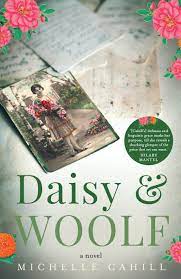In a class called Ideas in History held at the University of Technology, Sydney my tutor said, ‘Mothers are the keepers of culture.’ I heard that sentiment many times during that semester, reiterated as we learned about the exploitation and rape of India by the British empire – spearheaded by the East India company. It is a dark part of my ancestral history. The British targeted our cotton, our sugar, our jewels, they also targeted our women and our mothers. Throughout that semester, I reaffirmed the British empire was an insidious plague that infected White superiority and savourism through the world which continues to flare to this day. I also concluded that women are the key to our past and to our future because they are bridges to tradition, culture, and history, especially my own.
The argument that women give and receive the most important parts of culture, tradition, and often forgotten history is explored in Michelle Cahill’s latest novel, Daisy and Woolf. Traversing all over the world, the story follows protagonist Mina, an Anglo-Indian woman. She is unable to write because of the grief she experiences after her mother’s slow decline into dementia and death. Mina is only able to brave the pen again after her mother implores, from beyond the grave, to finish her writing: “Yet still, how it dawns on me now with the envelope fulfilling its destiny in my hands, that I had taken our relationship in this world for granted[.]” It is through the relationship of mother and daughter that the overlooked Anglo-Indian character, Daisy, from Virginia Woolf’s Mrs Dalloway, finally has a voice of her own.
Cahill’s Daisy and Woolf is a postmodernist triumph because it demands truth telling even in works of the most established literary canon. Cahill achieves this through the ongoing motif of Mina’s mother. Her mother’s journey from Nairobi, England, Australia and her experiences of being an Anglo-Indian woman ground Mina as she imagines the fictionalised life of Daisy. “How much more difficult it would have been for Daisy Simmons to immigrate. I have to give Daisy a voice and a body.” By weaving and threading the life of Daisy together through thoughtful research to understand the socio-political context of the colonised India.
Originally in Mrs Dalloway, Daisy is a side character, used by Woolf to serve as a literary plot device. One that simply emphasises the intellectual athleticism and former romantic tension between the white characters Peter Walsh and Clarissa Dalloway. Yet, like many characters of colour in Western literature, Woolf did not identify Daisy as important enough to warrant any further inspection into her life, background or motivations. By Mina filling in this notable gap, the Western literary canon is made whole. The Daisy from Daisy and Woolf, arguably the true Daisy, brings forth the complexities Anglo-Indian women have been facing for hundreds of years.
Yet at times, it is hard to sympathise with Daisy. For me, the most difficult scenes were those that included the character of Radhika – a maid that travelled with Daisy from Calcutta. As someone descended from indentured labourers, it was a reminder of how expendable ‘coolies’ and lower-caste Indians were and are still to this day. Cahill doesn’t shy away from Daisy’s privilege but rather leans into them, providing a raw tableau of colonial society.
Through the journal writings of Daisy, fictionalised by Mina, both women find their own strengths and are emboldened to make choices that serve each other. By writing Daisy’s voice, Mina’s grows louder too “I am like Daisy, taking risks, leaving everything behind for the idea of tomorrow. Daisy’s story.”
It is the seeds of Virginia Woolf’s work, nurtured and tenderly expanded upon by Mina, that make Daisy and Woolf worth reading. It is a book of masterful prose, which brings about a necessary unpacking of the English literary canon with its many layers of class, caste, gender, sexuality, race and colourism.

